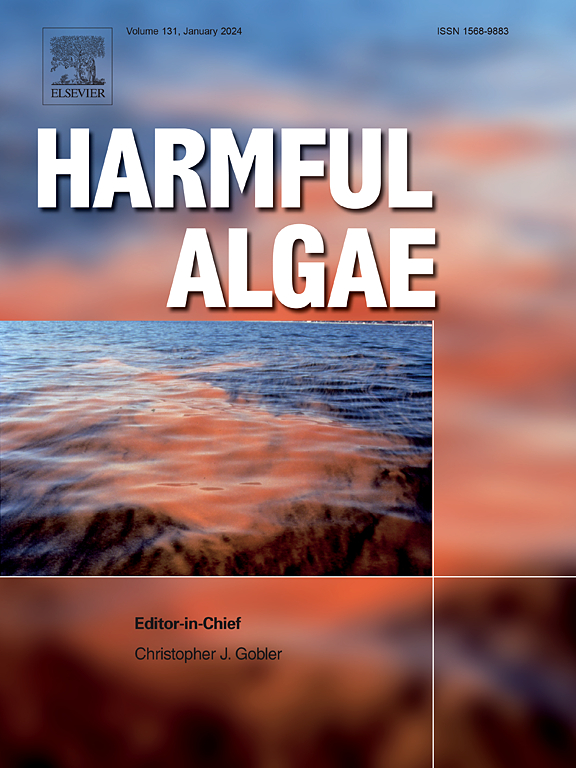盐度和光照对小樱草生长和樱氨酸细胞配额影响的种内差异
IF 4.5
1区 生物学
Q1 MARINE & FRESHWATER BIOLOGY
引用次数: 0
摘要
Prymnesium parvum产生具有裂解特性的大聚醚化合物(prymnesins),这些化合物在细胞中积累或可能释放到周围环境中。在细胞丰度高的情况下,前置蛋白会对生态系统造成毁灭性的破坏。在内陆水体和咸淡咸淡的沿海地区经常报道细小假单胞虫的水华,因此盐度被认为是控制水华的主要调节因素。然而,毒性主要是通过生物测定来评估的,缺乏非生物因素对春氨酸产生的影响。在这里,我们探讨了盐度和光照对三株小芽孢杆菌春氨酸产生的影响。我们发现parvum可以在很宽的盐度范围内生长,但与之前的建议相反,细胞prymnesin的净生产在低盐度下受到抑制,可能是由于资源被转移到处理低氧胁迫。在两个菌株中,在盐度诱导的压力下,增加的细胞前赖氨酸配额是由于细胞分裂率低而在细胞中积累毒素所致。我们进一步观察到细胞对光的生理反应在种内的差异。我们发现生长速度和细胞前体蛋白配额之间普遍存在负相关关系,无论是在菌株内部还是在菌株之间。总的来说,我们发现细胞生理对盐度和光照的反应有很大的种内变化,但展示了几种一般模式。这种广泛的种内变异可能部分地解释了各种小疟原虫菌株在广泛的环境中取得成功的原因。本文章由计算机程序翻译,如有差异,请以英文原文为准。
Intraspecific differences in the effects of salinity and light on growth and prymnesin cell quota in Prymnesium parvum
The haptophyte Prymnesium parvum produces large polyether compounds (prymnesins) with lytic properties that accumulate in the cell or may be released into the surrounding environment. At high cell abundances the prymnesins cause devastating damage to ecosystems. Blooms of P. parvum are frequently reported in inland water bodies and brackish coastal areas, and thus salinity has been suggested as a main regulatory factor in bloom control. However, toxicity has mainly been assessed through bioassay and the effect of abiotic factors on prymnesin production is lacking. Here, we explore the effect of salinity and light on prymnesin production in three strains of P. parvum. We find that P. parvum can grow over a wide range of salinities, but that net production of cellular prymnesin is, contrary to previous suggestions, inhibited at low salinities, presumably due to resources being diverted to deal with hypoosmotic stress. In two of the strains, increased cellular prymnesin quotas during salinity-induced stress were instead due to accumulation of toxins in the cells because of low cell division rates. We further observed intraspecific differences in cell physiology in response to light. We found general negative relationships between growth rate and cellular prymnesin quotas, both within and among strains. Overall, we find large intraspecific variation in cell physiology in response to salinity and light but demonstrate several general patterns. Such broad intraspecific variation may partly explain the success of various strains of P. parvum in a wide range of environments.
求助全文
通过发布文献求助,成功后即可免费获取论文全文。
去求助
来源期刊

Harmful Algae
生物-海洋与淡水生物学
CiteScore
12.50
自引率
15.20%
发文量
122
审稿时长
7.5 months
期刊介绍:
This journal provides a forum to promote knowledge of harmful microalgae and macroalgae, including cyanobacteria, as well as monitoring, management and control of these organisms.
 求助内容:
求助内容: 应助结果提醒方式:
应助结果提醒方式:


